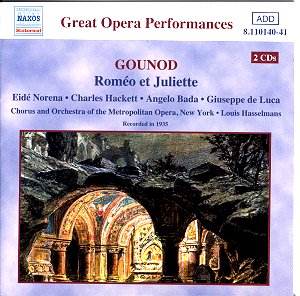No
recordings of Roméo et Juliette were made in the era of
78s although many leading singers recorded arias from the opera.
Indeed, complete recordings from the LP and CD era are sparse.
I therefore first of all welcome this issue, despite some limitations
of sound and the intrusion of applause, on the basis that it provides
opportunity to hear 1930s singing style in this work and serves
as a low budget introduction to the work.
The
‘Met’ roster of singers in the 1930s included some of the outstanding
artists of the day, often to be heard singing outside what might
be considered their usual fach, as is de Luca here. The Saturday
afternoon matinee broadcasts commenced in 1931 and provided an
opportunity for a wide public to hear the performances. Recordings
of the broadcasts were often attempted using pre-grooved discs,
with very disappointing results. However, professional studios
began recording for archival, and private commission purposes,
using aluminium discs with significantly better results. This
issue uses such discs, preserved by the son of Charles Hackett
who sings the role of Roméo and from which miracle restorer
Ward Marston has produced a very listenable performance. Yes,
there is surface noise that derives from the corroded edges of
the aluminium discs and there are moments of distortion, unfortunately
at the start of Juliette’s ‘Waltz Song’, CD1 tr.5. Some potential
purchasers might be less tolerant of the intrusion of applause,
regularly at the end of arias, but also at the entrance of favorite
singers such as for de Luca. CD1 tr. 2. Most infuriating however,
at least for me, is the regular narrative, even overlapping the
opening bars of an Act, of the broadcast narrator.
Given
the above reservations I still welcome this issue for the reasons
given, but most importantly for the quality of the performance
of the soloists, chorus, and particularly, the conductor. The
Norwegian Eidé Norena, a renowned Gilda who lived in Paris
from 1928 and was a favorite at the ‘Opéra’, sings Juliette.
Despite her 51 years she sounds appropriately young, whilst her
vast experience and tonal depth permits generous characterization
particularly in her duets with Roméo; CD1 tr.12, the ‘Balcony
Scene’, CD2 tr.4, and the ‘Tomb Scene’ CD2 tr.9. Charles Hackett’s
Roméo is sung with strong virile tone. He has a touch of
metal in the voice that adds an edge in the more violent encounters
but he softens his tone as an ardent suitor of Juliette. Generous
tone and fine characterization are the hallmarks of de Luca’s
‘Ballad of Queen Mab’, CD1 tr.3. One of the greatest of baritones,
he made his debut in 1897 and first appeared at the Met in 1915;
he can also be heard on a 1940 Met broadcast of La Bohème
as well as innumerable re-issues of 78s singing alongside the
likes of Gigli, Pinza, Galli-Curci etc and in solo items. Friar
Laurence is sung by Léon Rothier (b.1874). His sonorous,
typically French bass voice has the odd unsteady patch but he
gives a thoroughly thought-through and impressive interpretation;
of note are CD1 trs.12-13 and particularly CD2 tr.6 where Friar
Laurence gives Juliette the phial that will induce her appearance
of death. All the principals and the well sung minor parts have
good clear diction, likewise the vibrant chorus.
The
idiomatic conducting of the Paris-born Louis Hasselmans, with
his innate feel for French opera, really gives the performance
the ultimate quality medal. Act 4 scene 2, including the ballet
is omitted. The booklet gives a track listing and synopsis as
well as artist profiles, a brief essay on the genesis of the opera
and comments on the singers in this performance. Those used to
recordings of this period will find this issue to be eminently
listenable and the performance captivating.
Robert
J Farr
see
also review
by Robert Hugill
Footnote
Robert Hugill and Robert
Farr, in their reviews claim that there
was NO complete recording of the opera
in the 78-rpm era. Well, if they mean
in the electrical era, that's correct.
However, there WAS a complete acoustic
recording of "Romeo", on 54
sides no less, made by Pathe as early
as 1912! It had a pretty starry cast
too: Yvonne Gall and Agustarello Affre
as the lovers, Marcel Journet as Friar
Laurentand Henri Albers as Capulet.
It's currently available in a CD transfer
on VAI (1064-3). Randy Stewart. RB
